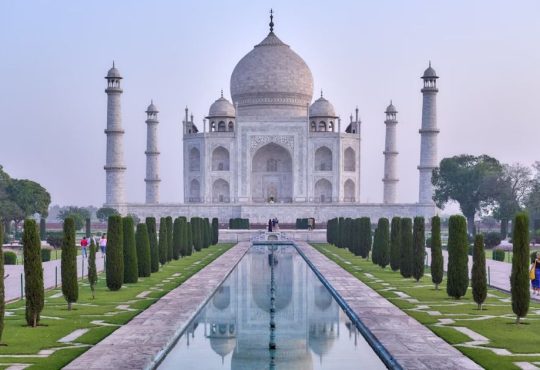From carved cliff sides to vibrant frescoes, unique temples and churches worldwide embody timeless symbols of faith and artistic brilliance. These architectural marvels serve as places of worship and cultural and historical touchstones, reflecting diverse narratives of belief and tradition. Through intricate carvings and richly adorned interiors, each structure tells a compelling story, bridging centuries of human creativity and devotion. Explore with us as we uncover these extraordinary sites that define the spiritual and cultural tapestries of nations across the globe.
Must-Visit Temples Tips: Top 10 Breathtaking Global Churches!
Angkor Wat
In Siem Reap, Cambodia, Angkor Wat is a monument to ancient Khmer architecture and spiritual devotion, sprawling across 402 acres. Originally conceived by Suryavarman II in the 12th century as a Hindu-Buddhist sanctuary dedicated to Lord Vishnu, its transformation into a predominantly Buddhist temple over time reflects the dynamic religious shifts in the region. Despite this evolution, rituals honoring Hindu deities with offerings of incense and fruits continue to be practiced by devotees, adding cultural richness to its spiritual significance.
Angkor Wat’s grandeur is unparalleled, making it the largest religious structure globally, recognized by the Guinness World Records. Its construction, spanning 28 years, involved the labor of thousands and resulted in the creation of intricately carved walls, a vast 5-km moat symbolizing the cosmic oceans, and numerous towers and galleries that serve as architectural marvels and spiritual sanctuaries.
Beyond Cambodia, the world hosts various extraordinary temples, each weaving its cultural and religious evolution narrative. The cliff-carved marvels of Petra in Jordan speak of ancient Nabatean ingenuity and trade routes. At the same time, the serene temples of Kyoto, Japan, reflect centuries-old Zen Buddhism and Shintoism traditions amidst peaceful garden settings. These temples are not merely places of worship but living testaments to human creativity, spiritual devotion, and the enduring power of architectural innovation across civilizations.
Exploring these sacred sites offers a journey through the cultural tapestries of nations, where architectural splendor meets profound spiritual significance. They invite visitors to delve into the rich histories and beliefs that have shaped societies over centuries, offering insights into the interconnectedness of human cultures and the universal quest for meaning and transcendence. Whether through intricate carvings, sacred rituals, or breathtaking natural settings, these temples and their surroundings inspire awe and reverence, serving as windows into humanity’s spiritual and cultural heritage.
Golden Temple
The Golden Temple revered as Harmandir Sahib is a testament to Sikh faith, resilience, and architectural magnificence. Originally constructed between 1581 and 1589, the temple endured tumultuous periods marked by invasions and destruction. Each phase of adversity led to reconstruction efforts overseen by successive rulers, culminating in a significant renovation under Maharaja Ranjit Singh in 1809. During this restoration, the sanctum’s pinnacle was adorned with 24-karat gold leaf. This defining feature bestows the temple’s splendid appearance today, adorned with over 750 kilograms of pure gold. This golden embellishment not only reflects Sikh devotion to their spiritual center but also symbolizes the enduring spiritual wealth and cultural heritage of the community.
The Golden Temple’s sacred significance is further enriched by its serene setting amidst the Amrit Sarovar pond. Here, pilgrims engage in the purifying washing ritual before entering the sanctum, signifying spiritual cleansing and preparation in Sikh tradition. Surrounding this tranquil waterscape is a pristine white marble complex that exudes tranquility and reverence. The architectural design, influenced by Islamic and Hindu styles, embodies the inclusive ethos of Sikhism, welcoming individuals of all backgrounds and beliefs through its four entrances, each symbolizing openness, equality, and unity among humanity.
Beyond its spiritual role, the Golden Temple is a vibrant community service and hospitality center. At its heart lies the langar, the world’s largest free kitchen, where volunteers tirelessly prepare and serve nutritious meals to thousands of visitors daily, irrespective of their social or economic status. This practice not only fulfills the Sikh principle of seva, or selfless service but also embodies the temple’s role as a beacon of compassion and communal harmony in Amritsar, India, fostering bonds of solidarity and goodwill among all who visit its hallowed grounds. Thus, the Golden Temple is not only a magnificent architectural wonder but also a profound embodiment of Sikh values and a cherished symbol of spiritual devotion and humanitarian service.
Pura Tanah Lot
Pura Tanah Lot, nestled in Bali, Indonesia, stands out for its distinctive temple architecture and profound spiritual significance. Its roots trace back to the 16th century when Dang Hyang Nirartha, a revered Hindu sage, visited the site and dedicated it to Balinese sea deities such as Bhatara Segara. Over time, the temple evolved into a place of worship honoring its creator, blending religious reverence with natural beauty. What distinguishes Pura Tanah Lot is its unique accessibility, accessible only during low tide when the pathway to the mainland emerges; during high tide, the temple appears to float atop the sea, earning it the moniker ‘the temple floating over the sea.’
Set against a backdrop of crashing waves and surrounded by Bali’s rugged coastal landscape, Pura Tanah Lot serves as a spiritual sanctuary and enthralls visitors with its breathtaking setting. Its architectural design, meticulously crafted to harmonize with the natural contours of the coastline, offers a serene and awe-inspiring glimpse into Bali’s cultural heritage and spiritual traditions. The temple’s strategic location enhances its allure, providing a panoramic view that invites contemplation and reverence, making it a cherished pilgrimage site and a symbol of Bali’s deep-rooted spirituality.
Visiting Pura Tanah Lot is a journey through architectural excellence and a profound exploration of the interplay between human creativity and divine presence amidst nature’s raw beauty. It is a testament to Bali’s rich cultural tapestry, where spiritual devotion and natural grandeur converge to create a timeless and unforgettable experience for all who witness its splendor.
Wat Rong Khun
Wat Rong Khun, widely known as the White Temple, stands as a captivating architectural marvel nestled in the serene landscapes of Chiang Rai, Thailand. Its construction, completed in 1997 under the visionary guidance of artist Chalermchai Kositpipat, reflects a harmonious blend of traditional Buddhist temple design with contemporary artistic expression. The temple’s exterior facade is a dazzling spectacle, adorned entirely in immaculate white, embellished with thousands of mirrored fragments that catch the sunlight, creating a shimmering effect that evokes a sense of ethereal beauty and spiritual purity.
At the heart of Wat Rong Khun lies a symbolic bridge that spans over a small lake, symbolizing the journey from worldly temptations to spiritual enlightenment. The bridge is flanked by intricate sculptures of outstretched hands, symbolizing the obstacles and desires one must overcome on the path to inner peace and spiritual awakening. Surrounding this central motif are meticulously crafted sculptures and reliefs depicting scenes from Buddhist mythology, each contributing to the temple’s narrative of spiritual guidance and moral teachings.
Visitors encounter a series of awe-inspiring structures inside the temple complex, including the ornate ‘Gate of Heaven’ and a glorious golden building that stands out against the backdrop of lush greenery. The interior walls are adorned with murals seamlessly blending traditional Buddhist iconography with contemporary cultural references. These murals depict scenes from Buddhist scripture and modern figures such as Superman, Michael Jackson, and Harry Potter, offering a unique fusion of spiritual symbolism and social commentary. This blend of ancient wisdom with contemporary themes invites contemplation on the timeless relevance of spiritual teachings in a rapidly changing world.
Venkateswara Temple
In the serene hill town of Tirumala, Andhra Pradesh, the Venkateswara Temple is a timeless symbol of devotion dedicated to Lord Vishnu. Local traditions trace the beginnings of this sacred site back to as early as 300 AD, highlighting its enduring spiritual significance across centuries. The temple’s setting amidst rolling hills provides a picturesque backdrop to its exquisite Dravidian architecture, which attracts pilgrims and tourists alike, drawn by its spiritual aura and grandeur.
One of the most distinctive aspects of the Venkateswara Temple is its unique marketplace, where devotees participate in a centuries-old ritual of offering human hair as a form of sacrifice. This practice, believed to be accepted by Lord Vishnu as a symbol of devotion and humility, adds a profound layer of cultural and religious significance to the temple’s atmosphere. The act of offering hair, meticulously woven into sacred rituals and beliefs, underscores the deep-rooted traditions that permeate every aspect of life in South India and enriches the spiritual experience for pilgrims who visit this revered site.
Beyond its religious rituals, the Venkateswara Temple is a vibrant center of pilgrimage and communal gathering, fostering a sense of unity and devotion among its visitors. The temple’s sacred pond, where devotees ceremonially cleanse themselves before entering the sanctum, symbolizes purity and spiritual preparation by Hindu traditions. This holistic experience, coupled with the temple’s architectural splendor and cultural resonance, invites pilgrims to immerse themselves in a journey of faith and spiritual renewal, making it a cherished destination for seekers of divine blessings and cultural enrichment.
Conclusion:
These remarkable temples and churches worldwide showcase stunning architectural feats and embody deep spiritual and cultural significance. From the ancient splendor of Angkor Wat in Cambodia to the tranquil elegance of the Golden Temple in India, each site reflects centuries of human devotion and creative expression. Pura Tanah Lot in Bali and Wat Rong Khun in Thailand offer unique perspectives on religious symbolism and artistic innovation. At the same time, the Venkateswara Temple in Tirumala, India, stands as a living testament to enduring religious traditions and rituals. These sacred places invite exploration into the diverse narratives of belief and tradition that unite humanity across continents and centuries.





